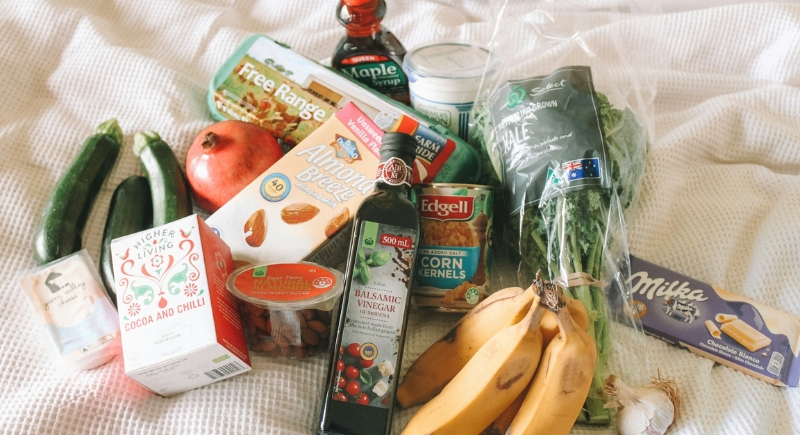What Is the 5‑4‑3‑2‑1 Grocery Plan, and Should You Try It?
We all know the drill. You walk into the grocery store with good intentions. You have a list, and you’re feeling productive, but somehow, you still walk out with a cart full of random items and a receipt that could pay rent for the month. If you’ve ever found yourself in this situation, you might be tempted to throw in the towel and order takeout instead. But what if there’s a way to change the game without breaking the bank or driving yourself mad over menu planning? Consider the 5-4-3-2-1 grocery shopping method. It promises to simplify shopping, reduce waste, and help you stay within your budget. But does it really live up to the hype? Let’s find out.
What Is the 5-4-3-2-1 Method?

Image via Unsplash/Charlie Wollborg
The 5-4-3-2-1 grocery method streamlines shopping trips by limiting the number of items you buy in each food category. Here’s how it works:
- 5 vegetables
- 4 fruits
- 3 proteins
- 2 sauces or spreads
- 1 grain
Plus, one treat for yourself (because hey, you deserve it!)
Chef Will Coleman popularized this method. He shared it on social media, and it quickly went viral. The concept is simple, but its effect can be surprisingly transformative. The idea is that by limiting yourself to specific categories, you’ll have everything you need for the week, without buying extra stuff that ends up sitting in your fridge.
Why It’s Gaining Popularity
Grocery shopping can be a time-sucker and a source of stress. Many of us get stuck in a cycle of overbuying and underusing. The 5-4-3-2-1 method solves that problem.
Fewer category options can reduce decision fatigue. Instead of agonizing over which sauce to buy or how many fruits you should get, you stick to a simple formula that works.
It also works wonders for your wallet. If you’re anything like me, a quick grocery trip can easily escalate into an expensive haul, especially when you wander through aisles of snacks, novelty items, and impulse buys. The method forces you to stick to the essentials.
How to Make It Work for You

Image via Unsplash/William Zimdahl
If the thought of buying just five vegetables and four fruits seems like you’ll run out of options, fear not. The beauty of the 5-4-3-2-1 method is that it leaves plenty of room for flexibility.
The five veggies can include things like leafy greens, bell peppers, carrots, and sweet potatoes. Just get whatever suits your taste or what’s in season. Similarly, your four fruits can be mixed up.
You might want to buy chicken, eggs, and a plant-based option like tofu for proteins. Or, if you’re feeling adventurous, go for some fish or even lean cuts of beef. Fish is actually very healthy.
The two sauces or spreads could be as simple as your go-to marinara sauce and a jar of peanut butter. That’s all you need to make a variety of meals work.
Grain-wise, maybe you’re into rice this week, or you’d rather have pasta again. As long as it works for your meals, it’s cool.
As for that treat? That’s the 5-4-3-2-1 method’s idea of a little incentive. It adds a bit of joy to your otherwise practical shopping list.
The Pros: Why You’ll Love It

Image via Unsplash/Egor Myznik
By slashing your grocery list, you’re also cutting your bill. With fewer items on your list, you’ll find that you’re spending less and getting more out of your purchases. Plus, when you’re restricted to specific categories, you buy just what you need and use it. That means fewer wilted veggies and forgotten fruits end up in the trash. Lastly, while the method limits your choices in some ways, it actually encourages creativity. For example, you might mix and match your veggies, proteins, and grains into multiple weekly meals.
The Cons: What to Keep in Mind
Of course, nothing is perfect. The 5-4-3-2-1 method works for many people, but it may not fit everyone’s needs. If you have a large family or different dietary preferences, you might find that the method doesn’t provide enough variety. And let’s be honest, some of us might struggle to live with only one grain for the entire week. Where’s the diversity in carbs, right?
The method also doesn’t account for pantry staples like oils, spices, and condiments, which are often essential for cooking. If you love a lot of flavor in your meals, you might have to supplement your shopping list.
Should You Give It a Try?

Image via Unsplash/Maddi Bazzocco
If you’re looking for a way to simplify your shopping, reduce impulse buys, and ensure you’re using everything you purchase, the 5-4-3-2-1 method is definitely worth a shot. It’s a practical, no-nonsense way to shop while leaving room for flexibility and creativity in your meals. And if you love a good deal, it’s a game-changer for sticking to a budget without feeling deprived.
Ultimately, this method makes grocery trips more intentional and less stressful. So, if you’ve been overwhelmed by the thought of meal planning and grocery shopping lately, this might just be the solution you need to get your kitchen under control.